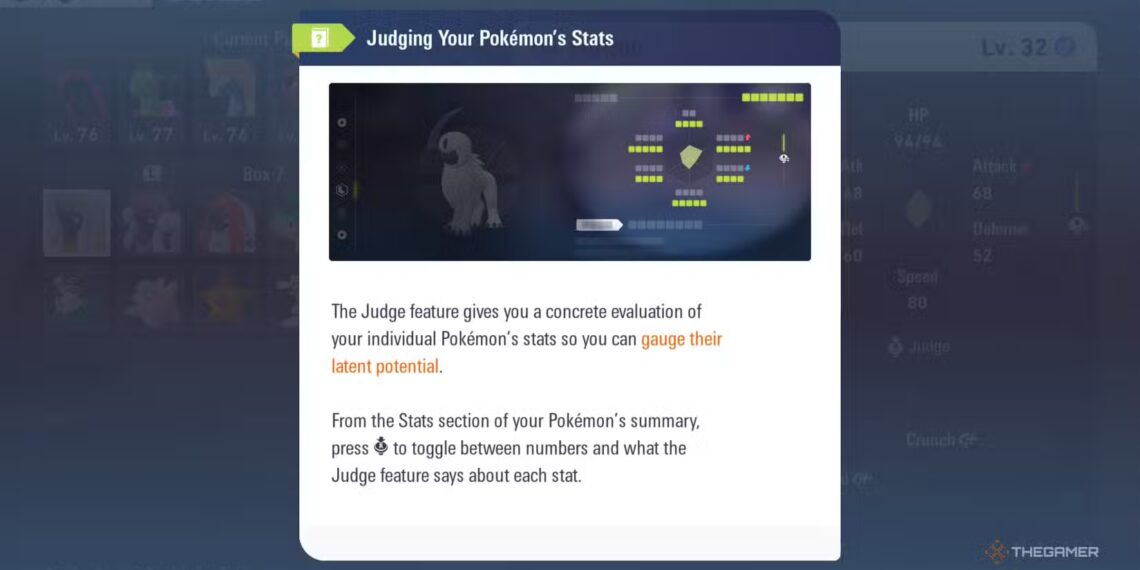Select Language:
Pokemon Legends: Z-A is a game focused on battling, and regardless of your skill level, defeating stronger opponents becomes tougher if your Pokémon have poor stats. With Lumiose City hanging in the balance, using Pokémon that naturally excel in battles is the best strategy.
But how can you tell how strong a Pokémon truly is? Hidden stats called IVs reveal a Pokémon’s potential, but they aren’t obvious at first glance and require some understanding. To really gauge a Pokémon’s strength, you need to learn about its personality and work through challenges to better understand its abilities.
What Are IVs?
IVs, or Individual Values, are the innate stats a Pokémon has when you get it. They influence how well each of its stats—like Attack, Defense, Speed, etc.—will grow as it levels up. IVs range from 0 to 31, with 31 being the highest possible, indicating maximum potential in that stat. Most Pokémon have randomly assigned IVs, but Alpha Pokémon always have three stats with perfect IVs of 31.
What Are EVs?
EVs, or Effort Values, are points gained by defeating specific Pokémon. They influence stat growth over time. A Pokémon can have up to 252 EVs in a single stat and a total of 508 EVs across all stats. Each Pokémon defeated yields certain EVs; for example:
- HP: Kangaskhan, Clefairy, Audino, Cleffa — found in Wild Area 19
- Attack: Weepinbell, Pinsir, Heracross, Scyther, Phantump, Trevenant — in Wild Area 13
- Special Attack: Pyroar, Lampent — in Wild Area 17
- Defense: Lairon, Onix, Aron — in Wild Area 14
- Special Defense: Swablu, Altaria — in Wild Area 18
- Speed: Pikachu, Espurr — in Wild Zone 3
Using items like Power Bracers or Anklets from side missions or the post-game can increase EV gains. Each of these items can boost EVs earned from defeated Pokémon, making training more efficient.
How to Check IVs
You can’t see IVs until after finishing the main story. Once you’ve completed it, you can judge Pokémon by opening their summary and pressing the Right Joystick, which reveals their IVs. While this doesn’t show exact numbers, you can estimate their quality based on the judgment. The categories are:
- No good — IVs are very low
- Decent — 1-15
- Pretty Good — 16-25
- Very Good — 26-29
- Fantastic — 30
- Best — 31
You can also use third-party tools like Marriland’s Pokémon IV Calculator for more precise readings, especially for Pokémon at Level 5 or higher. This is most accurate at higher levels when EVs are easier to track.
How to Change IVs
In previous Pokémon games, hyper training allowed players to raise IVs to their maximum using Bottle Caps. The same feature exists in Legends: Z-A, but it requires unlocking the Training Dojo by progressing through the Fist of Justice storyline. Your Pokémon must be at least Level 50, and then you can talk to the woman next to Josée.
- Bottle Caps raise a single stat to 31
- Gold Bottle Caps boost all stats to 31
Once hyper-trained, a Pokémon’s stats will display “Hyper Trained!” when checked, indicating IVs have been maxed out. While useful, hyper training relies on rare items called Bottle Caps, which are hard to find and are usually obtained through side quests, special missions, or reward matches in the post-game.
How to Reduce EVs
If you make a mistake or want to lower EVs, you can use berries like Kelpsy to reduce a specific stat by 10 EVs or visit the Rust Syndicate office to wipe all EVs for a fee of Mega Shards. You can buy EV-reducing berries at the berry stand in Wild Area 8, a location worth remembering because Tomato berries are needed for certain side quests.
How to Judge IVs
After completing the main story, you unlock the ability to judge Pokémon. Open a Pokémon’s summary, scroll to the stats tab, and press the Right Joystick to view their IVs. Although it doesn’t give exact numbers, you can interpret the quality of each IV based on the judgment. To help with understanding, here’s a translation guide:
| Judgement | IV Range | Description |
|---|---|---|
| No good | Very low (0-15) | Weak potential |
| Decent | 1-15 | Below average potential |
| Pretty Good | 16-25 | Good potential |
| Very Good | 26-29 | Strong potential |
| Fantastic | 30 | Excellent potential |
| Best | 31 | Maxed out potential |
This way, even without precise IV readings, you can make educated guesses about a Pokémon’s strengths.







